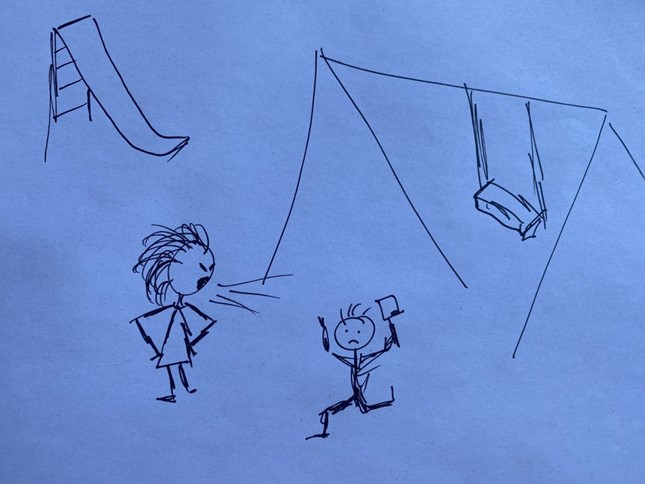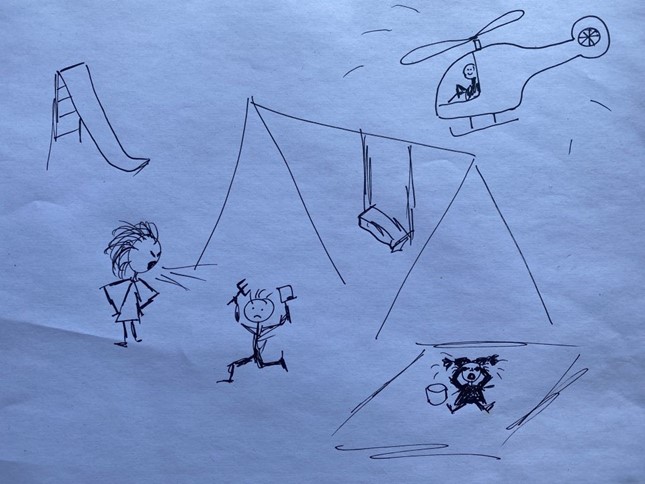5.3 Perceiving Others
In the previous topic, we focused on how individuals think and feel about themselves, and how they present themselves to self and others. In this topic, we will focus our attention on how people perceive others around them, as well as how they perceive situations. Kassin et al. (2020) use the term “social perception” to refer to “the processes by which people come to understand one another” (p. 93). The way we perceive others and make sense of one another frequently gives rise to conflict. You may recall that definitions of conflict frequently refer to “perceived” clashes of goals or values, so perception of others, what they want and what is important to them (as well as our perception of what is important to us) is fundamental to understanding and managing conflict.
As part of this topic, we will focus on understanding what types of information we seek about others, the observations and attributions we make when meeting others, and the perception errors we may make that may lead us to judge others and situations incorrectly. Understanding these aspects will help you understand your own ways of information seeking, observations, attributions and perception errors better. This understanding will also add to your conflict management “toolbox” to help you analyse conflict and support people in managing their conflict.
Observations
When trying to make sense of the world around us through observation, we tend to focus on three sources: situations, people and behaviour. We will now look at these sources in more detail.
Our perceptions of others are impacted by the beliefs that we hold about certain types of situations. These beliefs are influenced by both our personal experience with similar situations, as well as by our culture.
Research suggests that we also frequently form judgments of others based on their physical appearance. For example, a study found that features like round faces, large eyes and full lips lead people to judge the other as kind-hearted (Hassin & Trope, 2000). Other research has found that we form snap judgments based on another person’s physical appearance in the blink of an eye (Stewart et al., 2012).
When forming impressions of other, we not only pay attention to appearance, but also to others’ behaviours. Our interpretation of others’ feelings is heavily influenced by non-verbal behaviour, including facial expressions, body posture, tone of voice, etc. As you may remember from Chapter 3, much of the emotion research has focused on the human face and facial expressions to convey and anticipate others’ emotions, even though it is frequently impossible to correctly interpret others’ feelings by focusing on their face and facial expressions.
Besides facial expressions, other cues help us communicate and perceive others, including gaze and touch. When it comes to gaze, however, it is important to consider a person’s cultural background when trying to interpret other’s non-verbal cues. For example, gaze or eye contact is of particular importance in the Aboriginal culture (Adams et al., 2014; Westerman, 2021), and an acceptable amount of eye contact depends on factors like gender, age, and relationships between two persons (Sheldon, 2001; Trueman, 2013).
We have just learned that we base our impressions of others based on their physical appearance, their situation and people’s behaviours. But what if the others’ appearance and behaviours are not genuine and are meant to deceive us?
Extension:
Watch the following Ted Talk to learn about if and how you may be able to spot a liar [18:51]:
As the video suggested, it can be incredibly difficult to separate truth from a lie. In a study by Ekman and O’Sullivan (1991), even US Secret agents, who would have received specific training to detect liars, managed to judge others’ false statements only at a rate of 64%.
Extension:
To find out more about how we may spot a liar by focusing on language, please watch the following video [5:42]:
To learn more about how we perceive others through observation and the phenomenon of deception, please now read:
Reading
Attribution
For effective interaction with others, we need to be able to judge other’s intentions and feelings. The term “attribution” relates to how we infer a person’s personality traits, attitudes and abilities from the person’s statements and actions. Attributions also relate to the process of inferring the origins and/or reasons for people’s behaviours. Several theories help explain how we typically make these inferences, called attribution theories. Knowing about how attributions are made is of great importance to the work of conflict management specialists because they frequently need to understand what attributions people have made to be able to make sense of a conflict situation. They may also be able to help people understand and rethink their attributions to manage/resolve conflict. We will have a look at some attribution theories below.
Personal and Situational Attributions
Attribution theory holds that we tend to explain the behaviours of others by attributing the cause of the behaviour to either external factors, that is, the situation (situational attribution), or internal characteristics of a person (personal attribution). This theory is particularly important for conflict management since the way we attribute negative behaviour and events impacts who or what we blame to be the cause of a conflict.
Correspondent Inference Theory
Correspondence inference theory proposes that “people infer from an action whether the act corresponds to an enduring personal trait of the actor” (Kassin et al., p. 104). For example, we may infer from a mother yelling at her child in the playground that she is a generally aggressive individual.

Research has shown that people make these inferences about a person’s character based on the person’s behaviours, even when situational factors have a high impact on the person’s behaviour, a phenomenon referred to as the correspondence bias (Gawronski, 2004; Gilbert & Jones, 1986). Perhaps the mother mentioned above is not a generally aggressive individual, and she may have yelled at her son, because he has taken his sister’s shovel and rake for the third time, or she was yelling because a noisy helicopter was just flying across them. According to the correspondence bias, we would still infer that this mother is an aggressive individual, even if we noticed the crying sister in the sand pit or the noisy helicopter in the sky.

Three factors are thought to help people make these inferences, including whether
- the other had a choice when acting
- the action was expected
- there are specific or multiple possible effects when performing the act.
Knowing about these factors is of interest to conflict management. For example, practitioners may support a conflict party to explore these factors when analysing the inferences that the party has made about other conflict parties. This approach may help to broaden the conflict context and help shift the focus from personal attribution to situational attribution (see fundamental attribution error further below).
Covariation principle
According to Kelley’s (1967, cited in Kassin et al., 2020) covariation principle, people attribute behaviour to factors that are present when the behaviour occurs and are absent when the behaviour does not occur.
Attribution Biases and Heuristics
As we have learned in Chapter 2, our cognitions help us process information around us, including through our perception, attention, memory, language, problem-solving and decision-making. In the context of decision-making, we learned about several heuristics that we use to make decisions, such as the availability heuristic, and that are frequently prone to error. Similarly, we use error-prone heuristics when assessing the behaviours of others. Besides the cognitive heuristics and judgment errors to which you were introduced in Chapter 2 (and you might wish to revisit these now), the following effects have been found to impact our ability to correctly judge others’ behaviours:
The Fundamental Attribution Error and Conflict
The fundamental attribution error is central to understanding and supporting people in conflict since it is closely linked to how we lay blame and trust/ distrust others (Furlong, 2020). Above you were introduced to the situational and personal attributions. When we make a personal attribution in conflict, we lay full blame for negative events and behaviour on the other. In Furlong’s (2020) “Model #4: Dynamics of Trust”, Furlong considers three attributions instead of two, by further distinguishing personal attribution as either intentional or intrinsic.
Intentional attributions assume that a person intentionally acted in a particular way. For example, we may believe that our work colleague was deliberately late to a meeting with the intention to sabotage the discussion/ to punish us for having been late last time.
Intrinsic attribution attributes a person’s behaviour to their intrinsic nature and characteristics, such as age, cultural background, gender, level of education, etc. Considering again our work colleague, we may explain their lateness to the meeting by focusing on their culture (“they are from Fiji and people in Fiji just don’t care about time because they live on island time”). Other examples of intrinsic attributions are:
“Helmut always gives really harsh feedback to his students because he is German and Germans are blunt and not very sensitive people”.
“Lou always listens to loud music, because she is a teenager, and that’s just what teenagers do”.
As you may have guessed from reading about these examples, intrinsic attributions are frequently based on stereotypes. This type of attribution enables blame to be laid on both the person and the situation. After all, a person can’t be blamed for being a teenager or being from a particular cultural background. In combination with the fact that we use situational factors to explain our own behaviour, intrinsic, and especially intentional attributions for the behaviours of others have a detrimental impact on the level of trust that we may feel towards another person (Furlong, 2020). Lack of trust again is likely to further contribute to the formation and escalation of conflict, while making conflict management and resolution a much more difficult endeavour.
For other examples of the fundamental attribution (and the self-serving bias) and how this may impact conflict please watch the following short video [6:36]:
As another example of the link between the fundamental attribution error and conflict, Lindner (2014) notes about inter-group conflict:
Because the fundamental attribution error is so common to people’s conflict experiences, you may wish to reflect on a situation in which you may have made the fundamental attribution error.
Reflection Activity
Identify a situation that involved a negative event where you explained a person’s behaviours with either intentionality of the other or their intrinsic nature. Who or what did you blame for the behaviours/events that followed?
Now please think about how the situation/external factors may have contributed to the person’s behaviour and the negative event overall. Does this change your outlook on the person and how you lay blame?
Culture and Attribution
You may remember the Ted Talk by Lera Boroditsky, in which she discusses the impact of language on the way we assign blame for certain negative events (e.g., “he broke the vase” as opposed to “the vase was broken” – we watched this video in Chapter 2. If you haven’t watched the video yet you may want to do that now and skip straight to the section in which Boroditsky discusses how languages across the globe might differ in terms of how people describe negative events and their impact on laying blame (this starts at 9:00):
A study that investigated differences in attribution error between societies with collectivist and individualistic orientations found that with increasing age, American participants (predominantly an individualistic society) made more personal attributions, while Indian participants (considered a collectivist society) made more situational attributions (Miller, 1984). These findings suggest that the fundamental attribution error is more common in individualistic societies.
To learn more about attribution theories and biases, please now read:
Reading
Motivational Biases
Besides attribution biases, our perceptions and judgments of others are also influenced by our personal needs, wishes and preferences. These can be summarised under the term “motivational biases”. These biases include, for example:
Wishful Seeing
This bias relates to our tendency to see what we want to see (Dunning & Balcetis, 2013). We briefly touched on this topic in Chapter 2.
Have a look at the below image. Do you see the letter B or the number 13?

The image is adapted from research undertaken by Balcetis and Dunning (2006), who found that people noted seeing a B or 13 based on the perceived reward of seeing either the letter or the number. These findings support the idea that people may sometimes see what they want to see (you may remember learning in Chapter 2 that sometimes, “believing is seeing”).
Need for Self-Esteem
To boost their self-esteem, people tend to “take more credit for success than blame for failure” (Kassin, et. al, 2020, p. 114).
Belief in a Just World and Blaming the Victim
People tend to think that individuals get what they deserve, which helps people explain their own success. For example, they worked so hard for their well-deserved achievements, and others’ misfortune, after all. Laziness is punished with failure in society, right? The belief in a just world and the tendency also facilitates the process of blaming victims for their misfortune.
To learn more about the belief in a just world, you might want to watch this video [6:32]:
To learn more about motivational biases, please now read:
Reading
Integration: From Dispositions to Impressions
Below, we will consider in some more detail how we integrate pieces of information about the person that lead us to make inferences about the person overall. This process is referred to as “impression formation” (Kassin et al., 2020, p. 116).
To learn more about how this process works, please watch the following short video [2:13]:
Information integration theory proposes that we form impressions based on
- a person’s personal dispositions and the current state of the perceiver
- a weighted average of the target person’s characteristics (Kassin et al., 2020, p. 116)
As with other elements of social perception, the process of impression formation is not straightforward but may be influenced by various elements and processes, including:
To learn more about these and other effects and characteristics that may influence the impressions that we form of others, please now read:
Reading
Confirmation Biases
Once we have formed an impression of someone or something we are unlikely to change these impressions. This is the case even when our impressions are based on incomplete information and new evidence is presented to us. You were introduced to the “confirmation bias” one reason for this phenomenon in Chapter 2. This bias refers to the tendency of people to look for information that confirms their prior hypothesis (including, but not limited to their opinions and attitudes), and ignore information that might refute it. Confirmation bias can have significant consequences, including in the context of medicine, crime investigation and criminal justice (e.g., for investigators, judges and juries in criminal justice). For example, one study found that early assumptions about a suspect in a criminal investigation impacted how participants went on to collect evidence (O’Brien, 2009). One confirmation bias is particularly important to how conflict escalates and persists over time: the self-fulfilling prophecy (Pruitt & Kim, 2004).
A self-fulfilling prophecy occurs when a person’s beliefs and attitudes about someone lead that person to behave in ways that confirm those expectations. This phenomenon works between two parties as follows:
- Party A holds certain beliefs and attitudes about Party B, even if these are not true
- Party A behaves towards Party B consistent with their original beliefs and attitudes
- This behaviour in turn prompts or reinforces Party B to behave in a way that is consistent with Party A’s expectations
For example, if a parent believes that their child is lazy and consistently comments on this laziness, then the child may eventually behave accordingly. The self-fulfilling prophecy can also have positive impacts, such as that positive expectations about another person might encourage that person to improve performance, as demonstrated in research by Rosenthal and Jacobson (1968). Nevertheless, in conflict situations, self-fulfilling prophecies tend to reinforce negative conflict behaviours that contribute to the escalation of conflict.
To learn more about the self-fulfilling prophecy and other confirmation biases, please now read:

